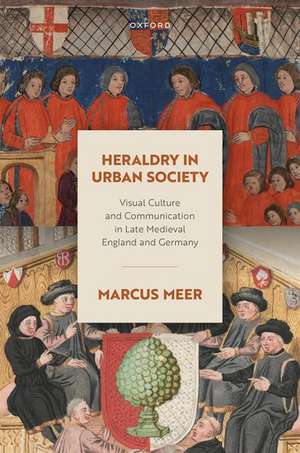Heraldry in Urban Society: Visual Culture and Communication in Late Medieval England and Germany: Oxford Studies in Medieval European History
Autor Marcus Meeren Limba Engleză Hardback – 6 noi 2024
Din seria Oxford Studies in Medieval European History
- 30%
 Preț: 563.65 lei
Preț: 563.65 lei - 26%
 Preț: 599.49 lei
Preț: 599.49 lei -
 Preț: 317.61 lei
Preț: 317.61 lei - 26%
 Preț: 559.15 lei
Preț: 559.15 lei - 25%
 Preț: 509.93 lei
Preț: 509.93 lei - 15%
 Preț: 267.71 lei
Preț: 267.71 lei - 12%
 Preț: 297.64 lei
Preț: 297.64 lei - 12%
 Preț: 194.68 lei
Preț: 194.68 lei - 30%
 Preț: 782.78 lei
Preț: 782.78 lei - 27%
 Preț: 541.20 lei
Preț: 541.20 lei - 7%
 Preț: 197.15 lei
Preț: 197.15 lei - 30%
 Preț: 790.32 lei
Preț: 790.32 lei - 30%
 Preț: 672.55 lei
Preț: 672.55 lei - 30%
 Preț: 590.89 lei
Preț: 590.89 lei - 26%
 Preț: 670.93 lei
Preț: 670.93 lei - 17%
 Preț: 581.72 lei
Preț: 581.72 lei - 17%
 Preț: 581.63 lei
Preț: 581.63 lei - 17%
 Preț: 690.25 lei
Preț: 690.25 lei - 25%
 Preț: 692.55 lei
Preț: 692.55 lei - 30%
 Preț: 593.75 lei
Preț: 593.75 lei
Preț: 596.18 lei
Preț vechi: 852.19 lei
-30% Nou
Puncte Express: 894
Preț estimativ în valută:
114.08€ • 119.41$ • 94.95£
114.08€ • 119.41$ • 94.95£
Carte disponibilă
Livrare economică 26 februarie-04 martie
Preluare comenzi: 021 569.72.76
Specificații
ISBN-13: 9780198910275
ISBN-10: 0198910274
Pagini: 336
Ilustrații: 19 colour images and 61 black and white images
Dimensiuni: 165 x 240 x 25 mm
Greutate: 0.72 kg
Editura: OUP OXFORD
Colecția OUP Oxford
Seria Oxford Studies in Medieval European History
Locul publicării:Oxford, United Kingdom
ISBN-10: 0198910274
Pagini: 336
Ilustrații: 19 colour images and 61 black and white images
Dimensiuni: 165 x 240 x 25 mm
Greutate: 0.72 kg
Editura: OUP OXFORD
Colecția OUP Oxford
Seria Oxford Studies in Medieval European History
Locul publicării:Oxford, United Kingdom
Notă biografică
Marcus Meer is a historian of medieval communication and visual culture, with a comparative focus on the towns and cities of England and the German-speaking lands, c.1300-1530. He is particularly interested in intersections of economic and cultural history, the communicative construction of identities, institutions, and spaces, and antagonisms and convergences of urban, monastic, and noble culture. Meer completed his Ph.D. at Durham University as a Leverhulme Doctoral Scholar (in a cotutelle arrangement with Münster University) and taught at Durham, King's College London, and Düsseldorf University. Currently, he is a Research Fellow at the German Historical Institute London.
